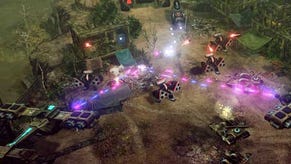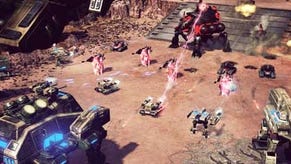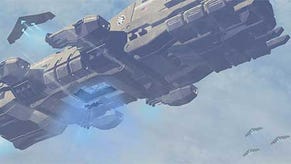NOD And A Wink: C&C4's Producer Explains All
Last week I sat down Jim Vessella, one of the producers at EA LA working on next year’s Command & Conquer 4. In between having our ears blasted by someone testing the building’s fire alarm, which did admittedly add an appropriate sense of apocalypse to proceedings, we chatted about how and why the RTS genre has changed, the split between single and multiplayer strategy, and how seriously we’re really supposed to take C&C’s campy cutscenes. A couple of key facts to know if you’ve not caught any preview details on C&C4 – the traditional base-building is replaced by a mobile MCV that spits out units and turrets, depending on which of three player classes you choose. No harvesting, no building upgrades – just straight-up war, akin to Dawn of War II and/or World in Conflict. Oh, and you’ll gain persistent experience points as you play, which unlocks new units and abilities.
Has RTS failed – is it essential that there is a major change after years of this Dune 2-derived thing?
I don’t think that it’s failed. I think that it’s become a little limiting in terms of what players can come into the genre. I think in terms of serving the hardcore market, that we usually call the classic base-on-base RTS gameplay, we’ve served them pretty well. I think Red Alert 3 was a great game for that type of audience, Starcraft 2 is going to a great example of a game for that type of audience.
But what we found was that it’s really tough for new players to come in and play a game like RA3, especially those who didn’t grow up in the generation of that style, who didn’t go through the days of C&C, Starcraft and Warcraft II. So what you’ve seen is that the market’s just shrunk a little bit and shrunk a little bit and shrunk a little bit…
So what we want to do is try and open it up to a new gerantion of gamers who want to try strategy but are too intimiated to go and play online in a Starcraft II match, cos they’re gonna get Zerged rushed. So I wouldn’t say that the genre’s failed – I’d say that it needs a bit of a kickstart to bring in new players. It just needs to evolve a little bit. I think we’ve seen that happen in other genres as well, over the years.
Is that about today’s gamers wanting things to be easier and more accessible, or is about the genre stagnating?
Personally, I love it when games introduce me to the aspects and mechanics a bit more easily. Sure I love a great war sim that just throws you in there and it’s got all these layers of depth and tactical fidelity and stuff, but I also just love a game that handholds you through the whole experience. When it’s really just about having fun and you get to experience a great story and a great universe, and that’s awesome too.
If you look at the numbers, a lot of people feel that way. They just want an experience where they can get the game and have a great time over a 10 to 12 hour period – and sometimes it’s hard to do that in an RTS. So what we’re trying to do is take some lessons from some of the other genres out there, and hopefully it works out.
Is introducing the new elements, like the roleplaying system that’s similar to that in Dawn of War II or the class system that’s a bit like World in Conflict, something that’s happening as a general, unconscious trend, or are RTS developers actively inspired by each other?
Obviously there’s a lot of “you learn from this game, you borrow from this game” – whatever you want to call it – and you put that in yours. I think that’s great. As a gamer, I want to get a game and I want to have fun with that. If that means that 30% of your gameplay came from this other 90%-rated game, that’s fine. As long as you did something that also added to the value of that experience – you added something new here yourself.
In terms of the progression mechanic, what I’ve always thought is when I get a new RTS game and I try out multiplayer for the first time, all of sudden I’ve got 50 units, 20 upgrades and 30 structures just dropped on top of me. I’ve no idea what anything does, what counters what, what weaposn this is good against. I’m just so intimidated, and I get rushed, and then I die.
So what we’re trying to do is introduce you to things a little bit slower, so that you can learn what everything does, and by the time you’ve put those hours into it you have this big inventory of stuff, and you’re like “oh, I know what all this stuff does, I know exactly where it fits, and now I can start really thinking about the strategy of I can combine this with this and that’s going to great in that suituation…”
Are you confident that the singleplayer is going to representative of the online experience too? You’ve reference Dawn of War II as doing some similar things, but one of the places that did fall down is there was such a hard-shift between singleplayer and multiplayer…
Yeah, the first time you go online [in Dawn of War II], you just get [smacks table and makes squelchy raspberry noise]. It’s a totally different experience. So I don’t think that our transition from singleplayer to online is going to be as drastic as Dawn of War II. Your objectives are going to be very similar in terms of capturing some of these nodes, using your Crawler, building out units, switching between different classes…
A lot of that game mechanic is going to be very similar, from singleplayer to online. Another cool thing is in skirmish, even, you can do a comp-stomp and then that’s going to be very similar to the online experience. I think if you train up in campaign and skirmish then you’re going to fit right into online. And again, with online being such a social experience of 5-on-5 gameplay, you can kinda learn from observing the other nine players on the map, and you can lean on them in the first few sessions. It’s not just you alone in a one on one map, getting rushed.
Are there going to be options for guys who do want the pure, classic, hardcore play?
We are investigating options. We’re not saying it has to be a 5-on-5 match. We’re looking at ways so that players can have 1 on 1 or 2v2; what we might do there is fiddle with how many units you can control, how big the maps are and things like that. We’re going to have levers in there, we hope, for how players can experience that. But the game modes will probably stay the same, so we’re not going to have that classic experience of you each start at a starting point, you build up a base, and then you just attack each other. We’re not focusing on that this time around.
Are you expecting outcry from fans when you say “there won’t be that, the cutscenes are going to be less humorous”?
The Tiberium universe has always tried to be a bit more serious…
Really?
Yeah. We tried. It did end up being campy most of the time…. I mean, Red Alert 3 is blatant “we’re trying to be comedic”. So I think people are going to enjoy the grittier tone of the cinematics. I think it’s kind of a cool contrast to what we just did with Red Alert 3. In terms of the gameplay, since we announced a few weeks ago, we’ve heard the feedback. Some people are really excited about the changes, and some of the more veteran players, the hardcore guys, are a little more wary about what it all means.
What I do want to remind fans is just because we’re changing the formula a little bit and taking out the classic base-building, it doesn’t mean that we’re necessarily removing strategic depth. There’s still lots of options in there in terms of moving around the battlefield, where you build your firebases, how you combine your units and how you combine with other players to push direction. So there is still a lot of strategic depth there, and that’s what we want fans to remember.
At the same time you’ve got to be able to drown out some of the shouting voices on the internet, right?
Oh yeah, it’s great – those are the guys that are really passionate about the franchise, and we feed off that energy as well, even if it is a little, ah, critical at times. So I do encourage them to keep speaking up.
Going back – you generally reckon that C&C 3 and Kane’s Wrath, cutscene-wise, was a pretty serious game? That fascinates me, to the point that I wonder if it’s just my British sense of humour / inability to take anything seriously, misreading it.
We wanted it to be serious, but it just comes off as campy. I think if you look at our announcement trailer for C&C4, I think we get away with being fairly serious – not too much to laugh at in there, unless you laugh at Joe Kucan’s quirky smile or something.
I’m thinking more stuff like that ridiculous cyber-hat he wears in Kane’s Wrath...
Yeah [laughs]. It’s sci-fi, y’know. There’s a very easy line to cross when in you’re in scifi, going from campy to being like Battlestar serious. We’re trying. We do really want to tell a great scifi story, one that has a bit of emotional depth in there, and a good story arc and character arcs. But, y’know. It comes off as campy sometimes – we’re not perfect. In C&C3 it was a little deliberate in a way, we wanted to harken back to what they did in 1995. We were trying to make it a bit more serious, trying to improve, but it made us come off as campy again. As long as people enjoy it, then that’s fine with us.
Have you been able to experiment at all with other forms of storytelling, seeing as you’re pushing against the series’ traditions anyway? Given how much you’re evolving the game in other ways, it seems almost anachronistic to have the hard-stop now-here’s-a-cutscene-and-then-a-mission structure again.
With this one we’re not trying too much different, apart from shooting the cinematics in a different way – in terms of not being those monologues to camera. Y’know, “this is the situation, commander” [wobbles head like a Thunderbird puppet]. We’re trying to get it a bit more like it’s in a film, the scene is evolving and you’re a fly on the wall watching that scene. We get to try something new every time, and that’s what we’re going for this time. We’ll see how people react to it. If people love it, then we might continue that type of storytelling. If people still feel it’s a little too 1990s, then yeah, we’ll try something different next time. I think it’s pretty cool what we’re doing this time though, and it’s going to turn out well.
What are the major lessons learned from C&C3 and RA3?
The main thing from RA3 was that the game was very lethal. You’d come in and you’d have your tanks, you’d come into a battle, and within a few seconds that battle would be over. So with C&C4, we’re trying to pull the lethality back, have battles take a little longer, so players can have time to learn how everything works. We’re putting a lot more visual cues into there in terms of what counters what, by changing effects colours, and trying to get a really solid counter system between weapon and armour types, learning some of the things that games like Warcraft have done. We felt that the affordance, what we call teaching the player visually what’s going on, was as strong in C&C3 and RA3 as we wanted it to be. So we’re trying to double down on that a bit and really make it more understandable for players this time around.
C&C4 arrives at some point next year, and I'm planning to tap out a preview based on the code I saw last week very soon.
Oh, and here's a bonus retrospective video, via German mag, GameStar:








